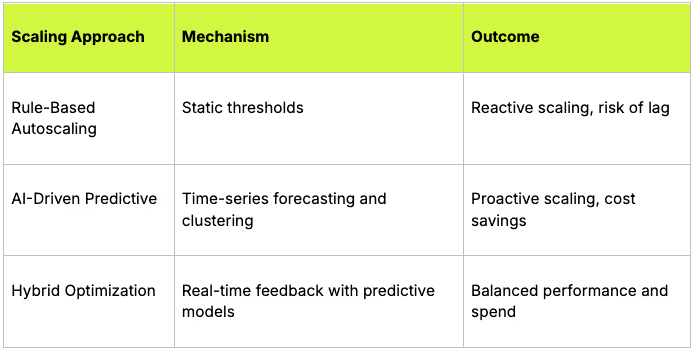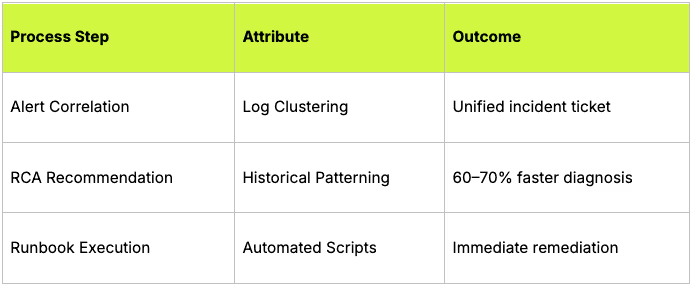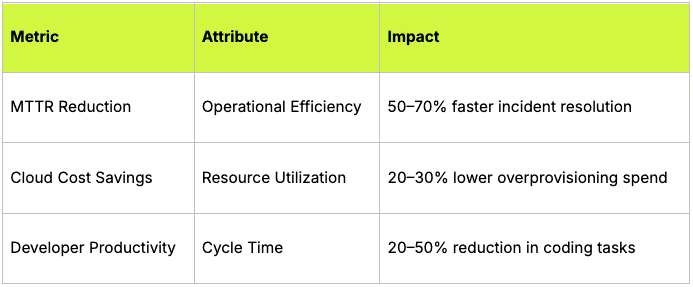

How AI is Transforming Platform Engineering: Key Uses and Benefits
AI in platform engineering is driving a paradigm shift by automating infrastructure, accelerating delivery pipelines, enhancing reliability, and elevating developer experience. As modern applications grow in complexity, engineering teams face manual toil, unpredictable scaling, and fragmented toolchains. AI-powered solutions promise to reduce errors, forecast capacity needs, enforce compliance, and free engineers to focus on innovation.
This article explores:
- Core AI applications in platform engineering
- AI-driven infrastructure automation for efficiency
- Developer-centric advances via internal developer platforms
- Reliability gains through AI in SRE operations
- Continuous integration and delivery acceleration
- Strategic outlook and emerging trends
- Adoption challenges, best practices, and ROI measurement
- Key open source AI tools for platform workflows
Together these themes reveal how AI is reshaping platform engineering from code to cloud, reliability to release.
What Are the Core Applications of AI in Platform Engineering?
AI in platform engineering unifies generative models, predictive analytics, and automated intelligence to streamline infrastructure, optimize cloud resources, and reinforce reliability. By leveraging machine learning and large language models, teams automate Infrastructure as Code (IaC) generation, forecast demand, enhance CI/CD pipelines, support SRE operations, and boost developer productivity. These foundational use cases set the stage for AI-powered transformation across the entire software delivery lifecycle.
How Does AI Automate Infrastructure as Code (IaC) Generation?
AI automates Infrastructure as Code (IaC) by using generative models to translate high-level specifications into Terraform, CloudFormation, Kubernetes manifests, or OpenTofu configurations. This mechanism reduces manual scripting errors and accelerates provisioning. For example, an LLM can parse a service description and produce a complete set of IaC modules, ensuring consistency and compliance.
- Accelerates module creation
- Enforces policy templates
- Minimizes drift through continuous validation
By automating IaC generation, teams maintain versioned infrastructure with minimal human intervention, paving the way for scalable provisioning and consistent deployments.
In What Ways Does AI Optimize Cloud Resource Management and Scaling?
AI optimizes cloud resource management by analyzing performance telemetry and usage patterns to predict capacity needs and automate scaling decisions. Machine learning models assess historical CPU, memory, and I/O metrics to anticipate spikes and adjust resources proactively.
Below is a comparison of approaches to resource scaling:

Predictive analytics reduce both overprovisioning and underutilization, leading to more efficient cloud spend and smoother user experiences.
How Is AI Enhancing Continuous Integration and Continuous Delivery (CI/CD) Pipelines?
AI enhances CI/CD pipelines by automating test generation, self-healing test suites, and intelligent release orchestration. Generative models can author unit and integration tests based on code changes, while anomaly detection algorithms flag flaky builds.
- AI-Generated Tests – Produces test cases from code diffs
- Self-Healing Suites – Detects and updates broken tests automatically
- Pipeline Orchestration – Prioritizes critical paths and parallelizes runs
This combination improves pipeline reliability, reduces time to feedback, and accelerates delivery cycles.
AI in CI/CD Pipelines
AI can be used to automate the collection and analysis of logs from builds, testing, and deployment done in the pipeline, and proactively predict where problems might occur in later steps or future runs. AI also helps to automate testing processes, which is critical for organizations that want to achieve continuous delivery.
AI-Driven DevOps
AI-driven DevOps relies on machine learning models and data analytics to optimize DevOps operations, including data collection and analysis, anomaly detection, predictive analytics, and automated decision-making. AI-driven automation speeds up CI/CD pipelines, reduces operational costs, improves reliability, enhances security, and reduces human intervention.
What Role Does AI Play in Site Reliability Engineering (SRE) and Operations?
AI in SRE centralizes observability, automates incident response, and predicts system failures to uphold reliability. By ingesting logs, metrics, and traces, AI-driven observability tools surface anomalies before user impact occurs.
- Anomaly Detection identifies outliers in real time
- Root Cause Analysis uses pattern recognition to suggest remediation
- Self-Healing auto-executes recovery runbooks
These capabilities lower alert noise, reduce mean time to recovery (MTTR), and maintain consistent service levels.
AI in SRE
AI's growing influence in Site Reliability Engineering (SRE) is revolutionizing the field by automating routine tasks, improving Incident Management, and enabling proactive, rather than reactive, maintenance. AI-powered monitoring and predictive analytics help prevent outages and reduce downtime.
How Does AI Improve Developer Experience and Productivity in Platform Engineering?
AI boosts developer experience by integrating into internal developer platforms (IDPs) as copilots, providing code suggestions, automating routine tasks, and enabling natural language interfaces. LLMs understand context, generate boilerplate, and offer smart completions, allowing engineers to focus on design and innovation rather than syntax.
- Contextual Code Generation accelerates feature development
- ChatOps Interfaces allow platform queries via conversation
- Cognitive Load Reduction automates repetitive workflows
These enhancements foster a self-service culture and streamline the entire developer journey.
AI and Developer Experience
AI adoption is showing clear correlations with improved productivity and developer experience. AI-powered tools can automate repetitive tasks, allowing developers to focus on innovative aspects of software development. AI coding tools can also help reduce the likelihood of coding errors and improve the accuracy of code, which ultimately leads to more reliable software, increased application performance, and better performance numbers for developers.
How Does AI-Driven Infrastructure Automation Improve Platform Engineering Efficiency?
AI-driven infrastructure automation leverages machine intelligence to provision, configure, and manage resources at scale. By combining policy engines with predictive analytics, teams achieve faster onboarding, consistent environments, and reduced operational toil.
What Are the Benefits of AI-Powered Automated Provisioning and Configuration Management?
Automated provisioning powered by AI interprets application requirements and enforces configuration policies without manual scripting. Generative models read service descriptors and infrastructure catalogs to spin up resources that comply with security, networking, and cost guidelines.
- Policy Enforcement ensures compliance by default
- Dynamic Cataloging selects optimal resource types
- Continuous Convergence reconciles drift in real time
This approach delivers secure, compliant infrastructure with minimal human oversight, enabling teams to onboard applications in minutes rather than days.
How Does AI Use Predictive Analytics for Resource Optimization and Cost Reduction?
Predictive analytics in platform engineering analyze utilization trends to forecast demand, optimize cloud spend, and allocate budgets more precisely. Machine learning models integrate billing data with performance metrics to identify saving opportunities.
Below is an illustration of predicted vs. actual spend optimization:

By aligning provisioning with true demand, teams achieve substantial cost savings and avoid manual budget revisions.
Which AI Tools Support Infrastructure as Code and Cloud Management?
Leading AI tools integrate with Terraform, Kubernetes, and cloud platforms to automate IaC and resource management:
- GitOps Platforms with AI agents for manifest generation
- AIOps Suites that apply ML to cloud telemetry
- Generative Plugins for Terraform that suggest modules
- env zero provides a comprehensive platform for managing IaC, Kubernetes, and other code frameworks with AI agents
These solutions bridge the gap between declarative infrastructure and intelligent operations, enabling seamless end-to-end automation.
How Is AI Enhancing Developer Experience Through Internal Developer Platforms (IDPs)?
AI-augmented IDPs embed intelligence directly into developer workflows, offering self-service portals, automated builds, and conversational interfaces. By integrating AI into platform layers, engineers gain context-aware assistance at every step.
What Features Do AI-Powered IDPs Offer for Self-Service and Automation?
AI-powered IDPs provide visual pipelines, no-code service templates, and guided pair-programming assistants. Generative UIs allow engineers to drag-and-drop architectures while AI translates their actions into orchestrated workflows.
- Service Scaffolding – One-click microservice generation
- Policy-Driven Templates – Ensure consistency across teams
- Interactive Assistants – Guide platform adoption via chat
These capabilities reduce onboarding friction and democratize platform usage across the organization.
How Do Large Language Models (LLMs) Assist in Code Generation and Intelligent Suggestions?
LLMs function as developer copilots by understanding code context, suggesting completions, and drafting entire modules. They accelerate coding tasks, propose optimizations, and surface documentation in real time.
- Auto-Completion of API calls
- Refactoring Suggestions for maintainability
- Contextual Documentation embedded in IDEs
By integrating LLMs into development environments, teams deliver higher-quality code with less manual effort.
How Are Natural Language Interfaces Transforming Platform Interaction?
Natural Language Processing (NLP) enables engineers to manage deployments, query logs, and adjust configurations via conversational agents. ChatOps bots facilitated by Model Context Protocol (MCP) servers translate plain-English commands into API calls and shell scripts, eliminating context switches.
- Conversational Provisioning – “Create a staging cluster”
- Real-Time Insights – “Show me errors in the last hour”
- Automated Runbooks – “Roll back the last deployment”
This frictionless interaction model boosts productivity and reduces cognitive overhead.
How Does AI Reduce Cognitive Load for Developers?
AI reduces cognitive load by automating repetitive tasks—such as environment setup, dependency management, and test data generation—allowing engineers to focus on creative problem solving. Contextual recommendations and anomaly alerts further shield teams from routine disruptions.
These productivity gains lay the foundation for higher-value engineering work and continuous innovation.
What Impact Does AI Have on Site Reliability Engineering (SRE) and Operational Excellence?
AI transforms SRE by enabling proactive monitoring, predictive maintenance, and automated incident workflows. Data-driven insights and intelligent remediation improve uptime and reduce manual intervention.
How Does AI-Driven Observability Detect Anomalies and Improve Monitoring?
AI-driven observability platforms ingest metrics, logs, and traces to establish baselines and detect deviations in real time. Unsupervised learning algorithms cluster normal behavior, flagging anomalies that signal potential issues.
- Automated Baseline Modeling
- Contextual Alerting minimizes noise
- Dynamic Dashboards highlight root causes
By detecting issues early, teams prevent outages and maintain service quality.
What Are the Benefits of Predictive Maintenance and Automated Remediation?
Predictive maintenance uses ML to forecast component failures—such as disk saturation or memory leaks—before they impact users. Automated remediation runbooks then execute corrective actions, achieving self-healing operations.
- Failure Prediction with 85–90% accuracy
- Automated Failover for critical services
- Resource Remediation to restore healthy states
These capabilities drive down unplanned downtime and operational costs.
How Does AI Automate Incident Response and Root Cause Analysis (RCA)?
AI automates incident response by correlating alerts, enriching context with topology data, and suggesting RCA paths based on historical incidents. Knowledge graphs link symptoms to past fixes, speeding up resolution.

This automation reduces MTTR and preserves team focus during critical events.
How Does AIOps Enhance SRE Practices and Reduce Mean Time to Recovery (MTTR)?
AIOps platforms blend AI with IT operations to continuously optimize monitoring thresholds, auto-tune alert severity, and orchestrate playbooks. By shifting from reactive firefighting to proactive resilience, teams achieve significant MTTR reductions and improved SLIs.
These innovations mark a new era of operational excellence in platform engineering.
How Is AI Revolutionizing Continuous Integration and Continuous Delivery (CI/CD) Pipelines?
AI revolutionizes CI/CD by infusing intelligence into every pipeline stage—testing, code analysis, and deployment management. Predictive insights and automation safeguard quality while accelerating releases.
How Does AI Improve Test Automation and Optimization in CI/CD?
AI improves test automation by generating test cases from code changes, optimizing test suites for coverage, and self-healing flaky tests. Neural networks analyze test outcomes to prioritize high-value scenarios.
- Smart Test Generation adapts to code diffs
- Flake Detection reduces false positives
- Suite Optimization shrinks build times
These advances ensure robust validation without ballooning pipeline durations.
What Role Does AI Play in Automated Code Quality and Security Analysis?
AI performs static and dynamic code analysis to detect vulnerabilities, performance bottlenecks, and style violations. Machine learning models trained on anonymized codebases uncover novel security patterns and maintainability issues.
- Vulnerability Scanning beyond signature matching
- Code Smell Detection for early refactoring
- Compliance Checks for licensing and standards
This continuous scrutiny elevates code integrity and accelerates safe deployments.
How Does AI Predict Failures and Optimize Deployment Processes?
AI predicts deployment failures by correlating build artifacts with historical rollout outcomes and environmental factors. Predictive release managers schedule deployments during low-risk windows and automate canary rollbacks.
- Failure Forecasting with pattern recognition
- Automated Rollbacks on anomaly detection
- Release Orchestration for blue-green and canary strategies
By anticipating issues, platforms achieve near-zero downtime and reliable delivery velocity.
What Are the Strategic Implications and Future Trends of AI in Platform Engineering?
AI’s strategic impact extends beyond tactical gains, unlocking cost optimization, security automation, ethical governance, and emerging autonomous platforms. Organizations must align AI initiatives with long-term platform strategies.
How Does AI Enable Cost Optimization and Operational Efficiency?
AI optimizes costs by right-sizing resources, forecasting spend trends, and automating savings plans. Advanced analytics pinpoint idle assets and recommend consolidation.
These efficiencies translate into higher ROI and sustainable platform scaling.
How Is AI Automating Security and Compliance in Platform Engineering?
AI automates threat detection, compliance auditing, and policy enforcement by continuously scanning infrastructure and code. Behavioral analytics recognize anomalous activities and trigger remediation workflows.
Such proactive security integration reduces risk and meets evolving regulatory requirements.
What Ethical and Governance Challenges Does AI Present in Platform Engineering?
AI brings challenges around bias in decision models, data quality, and the need for human oversight. Ethical governance frameworks must enforce transparency, explainability, and accountability in automated platform decisions.
Balancing autonomy with control safeguards both reliability and trust in AI-driven operations.
What Emerging AI Trends Will Shape the Future of Platform Engineering?
Next-generation trends include agentic AI agents that autonomously coordinate multi-step workflows, self-optimizing platforms that adjust architecture in real time, and AI-augmented digital twins for predictive system design. These advancements promise continuous self-tuning environments that anticipate business needs.
What Are the Common Challenges and Best Practices for Integrating AI in Platform Engineering?
Integrating AI in established platforms faces hurdles such as data quality constraints, toolchain complexity, and organizational resistance. Adhering to best practices mitigates these obstacles and accelerates adoption.
What Integration Challenges Arise When Implementing AI in Existing Platforms?
Organizations often struggle with siloed telemetry, inconsistent infrastructure definitions, and lack of AI expertise. Data fragmentation and legacy workflows impede model training and automation efforts.
Understanding these challenges guides targeted remediation and phased AI rollouts.
How Can Organizations Overcome AI Adoption Barriers in Platform Engineering?
Successful adoption relies on clear governance, cross-functional collaboration, and incremental pilots. Best practices include:
- Data Normalization across logs and metrics
- Skill Development through AI literacy programs
- Pilot Use Cases to demonstrate value quickly
These measures foster trust and build momentum for enterprise-wide AI integration.
How Is ROI Measured for AI Initiatives in Platform Engineering?
ROI calculations for AI projects combine cost savings—via automated remediation and optimized provisioning—with increased delivery velocity and reliability improvements. Common metrics include:

Quantifying these gains supports ongoing investment in AI-driven platform engineering.
Which Open Source AI Tools Are Available for Platform Engineering Workflows?
A growing ecosystem of open source AI tools empowers platform teams to adopt intelligent automation without vendor lock-in. These solutions span infrastructure automation, developer support, and pipeline optimization.
What Are the Leading Open Source AI Solutions for Infrastructure Automation?
Key tools include:
- Kube-GPT – AI-powered manifest generation for Kubernetes
- env zero – Policy-driven IaC analysis and automation with AI insights
- OpenAI Terraform Provider – Generates Terraform code from prompts
- OpenTofu Provider Integrations – Enables AI-assisted configuration for OpenTofu
Open Source AI Tools
Giskard is an open source AI platform that helps you evaluate and test large language model data for quality, accuracy, and security. MindsDB is an open source AI offering developers build AI-powered applications and automates machine learning frameworks into data stacks.
How Do Open Source AI Tools Support Developer Productivity and CI/CD?
Open source plugins and CLI tools integrate LLMs into editors and pipelines:
- GitHub Copilot CLI – AI assistant for shell and repo operations
- ML-based Test Generators – Projects like pytest-ai that create tests
- AI Security Linters – Tools such as semgrep-ai for vulnerability detection
By extending familiar workflows with AI, these tools accelerate development and harden releases.
What Resources Help Evaluate and Compare AI Tools for Platform Engineering?
Comprehensive evaluation frameworks include feature matrices, community maturity scores, and performance benchmarks. Guides and interactive dashboards from CNCF, GitHub, and independent research labs provide detailed comparisons of open source AI platforms.
Leveraging these resources ensures informed tool selection aligned with organizational goals.
Platforms that embrace AI in platform engineering gain unmatched efficiency, reliability, and innovation velocity. By automating IaC, optimizing resources, enhancing CI/CD, and empowering developers, AI reshapes every layer of modern infrastructure. As emerging agentic and autonomous platforms arrive, proactive governance, ethical frameworks, and ROI measurement will guide sustainable adoption. Organizations ready to integrate AI into their platform roadmap will secure a competitive edge in delivering resilient, scalable, and cost-effective digital services, powered by solutions like env zero.

.webp)

